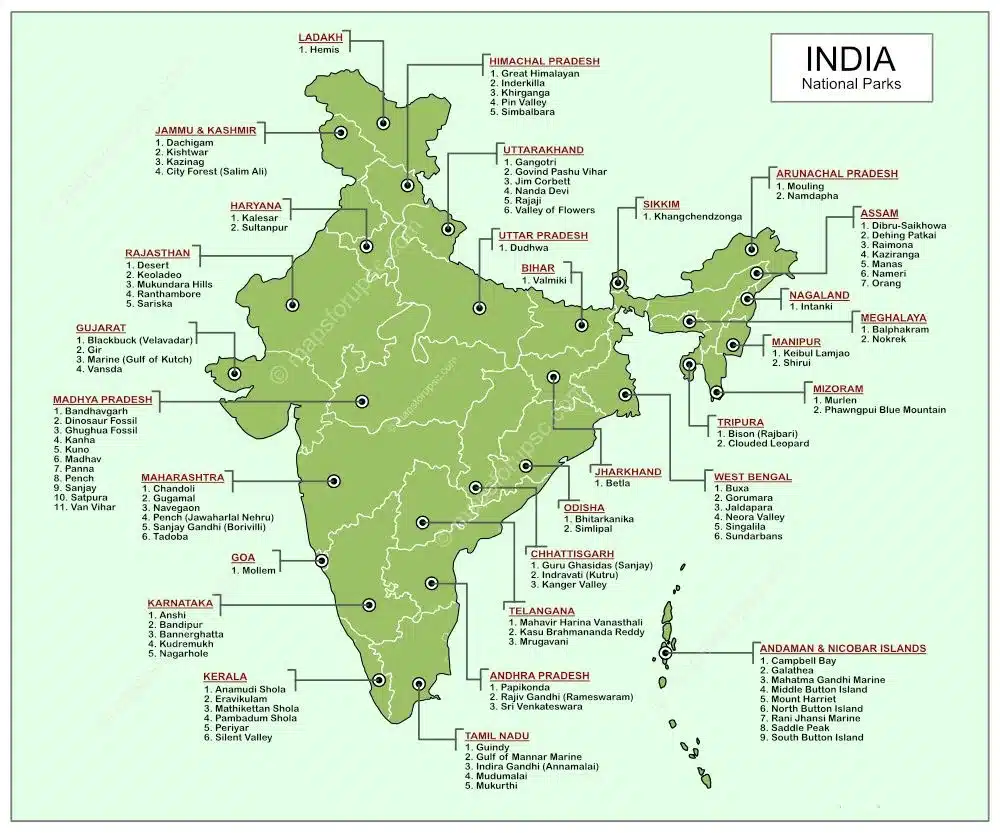National Parks in India: India is home to a diversity of National Parks and Wildlife Sanctuaries, each serving as a hub for biodiversity conservation. These government-protected areas are established to safeguard native wildlife, conserve plant and animal species, and help restore ecological balance. Currently, there are 107 National Parks in India and 544 Wildlife Sanctuaries across the country, with Madhya Pradesh and the Andaman & Nicobar Islands leading in numbers, each hosting nine National Parks.
National Parks in India
National Parks in India play a vital role in protecting wildlife and their natural habitats. These areas have strict rules that ban hunting, poaching, industrial activities, and farming to keep the environment undisturbed. With secure boundaries, no outside activities are allowed near or within these parks. The main purpose of National Parks in India is to conserve India’s diverse wildlife. Below is a List of National Parks in India 2025, which is useful for competitive exams and general knowledge.
List of National Parks in India 2025 State-wise
India proudly hosts around 107 national parks, each dedicated to preserving its remarkable biodiversity and distinctive landscapes. Here’s a List of National Parks in India 2025 State-wise, for easy reference.
| List of National Parks in India 2025 State-wise | |||
|
State/Union Territory |
Total Parks |
National Parks Name |
Establishment Year |
|
Andaman & Nicobar Islands |
9 |
Campbell Bay National Park |
1992 |
|
Galathea Bay National Park |
1992 |
||
|
Mahatama Gandhi Marine (Wandoor) National Park |
1982 |
||
|
Middle Button Island National Park |
1987 |
||
|
Mount Harriett National Park |
1987 |
||
|
North Button Island National Park |
1987 |
||
|
Rani Jhansi Marine National Park |
1996 |
||
|
Saddle Peak National Park |
1987 |
||
|
South Button Island National Park |
1987 |
||
|
Andhra Pradesh |
3 |
Papikonda National Park |
2008 |
|
Rajiv Gandhi (Rameswaram) National Park |
2005 |
||
|
Sri Venkateswara National Park |
1989 |
||
|
Arunachal Pradesh |
2 |
Mouling National Park |
1986 |
|
Namdapha National Park |
1983 |
||
|
Assam |
5 |
Dibru-Saikhowa National Park |
1999 |
|
1974 |
|||
|
1990 |
|||
|
Nameri National Park |
1998 |
||
|
Rajiv Gandhi Orang National Park |
1999 |
||
|
Bihar |
1 |
Valmiki National Park |
1989 |
|
Chhattisgarh |
3 |
Guru Ghasidas (Sanjay) National Park |
1981 |
|
Indravati (Kutru) National Park |
1982 |
||
|
Kanger Valley National Park |
1982 |
||
|
Goa |
1 |
Mollem National Park |
1992 |
|
Gujarat |
4 |
Vansda National Park |
1979 |
|
Blackbuck (Velavadar) National Park |
1976 |
||
|
1975 |
|||
|
Marine (Gulf of Kachchh) National Park |
1982 |
||
|
Haryana |
2 |
Kalesar National Park |
2003 |
|
Sultanpur National Park |
1989 |
||
|
Himachal Pradesh |
5 |
Great Himalayan National Park |
1984 |
|
Inderkilla National Park |
2010 |
||
|
Khirganga National Park |
2010 |
||
|
Pin Valley National Park |
1987 |
||
|
Simbalbara National Park |
2010 |
||
|
Jammu and Kashmir |
4 |
City Forest (Salim Ali) National Park |
1992 |
|
1981 |
|||
|
Kishtwar National Park |
1981 |
||
|
Jharkhand |
1 |
Betla National Park |
1986 |
|
Karnataka |
5 |
Anshi National Park |
1987 |
|
1974 |
|||
|
1974 |
|||
|
Kudremukh National Park |
1987 |
||
|
1988 |
|||
|
Kerala |
6 |
Anamudi Shola National Park |
2003 |
|
Eravikulam National Park |
1978 |
||
|
Mathikettan Shola National Park |
2003 |
||
|
Pambadum Shola National Park |
2003 |
||
|
1982 |
|||
|
Silent Valley National Park |
1984 |
||
|
Madhya Pradesh |
9 |
Bandhavgarh National Park |
1968 |
|
Fossil National Park |
1983 |
||
|
1975 |
|||
|
1955 |
|||
|
Madhav National Park |
1959 |
||
|
1981 |
|||
|
Sanjay National Park |
1981 |
||
|
1981 |
|||
|
Van Vihar National Park |
1979 |
||
|
Maharashtra |
6 |
Chandoli National Park |
2004 |
|
Gugamal National Park |
1975 |
||
|
Nawegaon National Park |
1975 |
||
|
Pench (Jawaharlal Nehru) National Park |
1975 |
||
|
Sanjay Gandhi (Borivali) National Park |
1983 |
||
|
1955 |
|||
|
Manipur |
1 |
Keibul-Lamjao National Park |
1977 |
|
Meghalaya |
2 |
Balphakram National Park |
1985 |
|
Nokrek Ridge National Park |
1986 |
||
|
Mizoram |
2 |
Murlen National Park |
1991 |
|
Phawngpui Blue Mountain National Park |
1992 |
||
|
Nagaland |
1 |
Intanki National Park |
1993 |
|
Odisha |
2 |
Bhitarkanika National Park |
1988 |
|
Simlipal National Park |
1980 |
||
|
Rajasthan |
5 |
Mukundra Hills National Park |
2006 |
|
Desert National Park |
1992 |
||
|
Keoladeo Ghana National Park |
1981 |
||
|
Ranthambhore National Park |
1980 |
||
|
Sariska National Park |
1992 |
||
|
Sikkim |
1 |
Khangchendzonga National Park |
1977 |
|
Tamil Nadu |
5 |
Guindy National Park |
1976 |
|
Gulf of Mannar Marine National Park |
1980 |
||
|
Indira Gandhi (Annamalai) National Park |
1989 |
||
|
Mudumalai National Park |
1990 |
||
|
Mukurthi National Park |
1990 |
||
|
Ladakh |
1 |
Hemis National Park |
1981 |
|
Telangana |
3 |
Kasu Brahmananda Reddy National Park |
1994 |
|
Mahaveer Harina Vanasthali National Park |
1994 |
||
|
Mrugavani National Park |
1994 |
||
|
Tripura |
2 |
Clouded Leopard National Park |
2007 |
|
Bison (Rajbari) National Park |
2007 |
||
|
Uttar Pradesh |
1 |
1977 |
|
|
Uttarakhand |
6 |
Corbett National Park |
1936 |
|
Gangotri National Park |
1989 |
||
|
Govind National Park |
1990 |
||
|
Nanda Devi National Park |
1982 |
||
|
Rajaji National Park |
1983 |
||
|
Valley of Flowers National Park |
1982 |
||
|
West Bengal |
6 |
Buxa National Park |
1992 |
|
Gorumara National Park |
1992 |
||
|
Jaldapara National Park |
2014 |
||
|
Neora Valley National Park |
1986 |
||
|
Singalila National Park |
1986 |
||
|
1984 |
|||
National Parks in India Map
There are 107 National Parks in India as of 2025 covering around 44,403 km2 covering the diverse including the Himalayas to coastal regions. The First National Park in India is Jim Corbett National Park which was initially known as Hailey National Park established in 1936 in Uttarakhand where as South Button Island NP in the Andaman & Nicobar Islands, which is referred as the Smallest National Park in India about 5 km². Below we have provided the National Park of India Map for the reference.
What is a National Park?
A National Park is a protected area established by the government under the Wildlife Protection Act, 1972 to conserve wildlife, flora, and natural ecosystems. These parks aim to safeguard biodiversity and provide a secure habitat for endangered species. Human activities like hunting, poaching, and commercial use of resources are strictly prohibited within their boundaries. National Parks also promote eco-tourism, environmental education, and scientific research to maintain ecological balance and awareness.
National Park in India Features
- Legal Protection: National Parks are legally protected; activities like hunting, grazing, and forestry are prohibited.
- Wildlife Conservation: They serve as safe habitats for endangered and native species of animals and birds.
- Ecological Balance: Helps in preserving ecosystems, biodiversity, and natural landscapes.
- Public Access: Generally open to visitors for education and eco-tourism under strict rules.
- Scientific Research: Provide opportunities for research, wildlife monitoring, and conservation studies.
Oldest National Parks in India
Corbett National Park, established in 1936, is the Oldest National Parks in India. Located in the Himalayas in Uttarakhand, it was initially named Hailey National Park. Renowned for its rich biodiversity, the park is especially famous for being the first area to come under the Project Tiger initiative in 1973. Jim Corbett Tiger Reserve is home to Bengal tigers, elephants, leopards, and hundreds of bird species, making it one of the most prominent wildlife sanctuaries in India.
| Oldest National Parks in India | |||
|
S.No |
National Parks in India |
Location |
Year |
|
1 |
Corbett National Park |
Uttrakhand |
1936 |
|
2 |
Madhya Pradesh |
1955 |
|
|
3 |
Tadoba National Park |
Maharashtra |
1955 |
Smallest National Parks in India
South Button Island National Park is the Smallest National Parks in India covering an area of just 5 sq.km. It is located in the Andaman and Nicobar Islands, off the southeastern coast of the Indian mainland. Despite its small size, the park is rich in marine biodiversity, offering vibrant coral reefs, sea turtles, and exotic fish species. It forms part of the Rani Jhansi Marine National Park and is a popular site for scuba diving.
| Smallest National Parks in India | |||
|
Rank |
National Park |
Location |
Area (km^2) |
|
1 |
South Button Island NP |
Andaman and Nicobar Islands |
0.03 |
|
2 |
Fossil National Park |
Madhya Pradesh |
0.3 |
|
4 |
North Button Island National Park |
Andaman and Nicobar Islands |
0.4 |
|
5 |
Middle Button Island National Park |
Andaman and Nicobar Islands |
0.9 |
|
7 |
Dinosaur Fossils National Park |
Madhya Pradesh |
1.4 |
|
8 |
Pambadum Shola National Park |
Tamil Nadu |
1.4 |
Newest National Parks in India
Dihing Patkai National Park is the Newest National Parks in India, established in June 2021. It is located in the Dibrugarh and Tinsukia districts of Assam and spans an area of 231.65km2. Known as the “Amazon of the East,” the park is rich in biodiversity and forms part of the largest stretch of lowland rainforest in India. It is home to rare and endangered species like the clouded leopard, hoolock gibbon, and several species of hornbills.
| Newest National Parks in India | |||
|
Rank |
National Parks |
Location |
Year |
|
1 |
Dihing Patkai National Park |
Assam |
2021 |
|
2 |
Raimona National Park |
Assam |
2021 |
|
3 |
Jaldapara National Park |
West Bengal |
2014 |
Largest National Parks in India
Hemis National Park is the Largest National Parks in India in India by area. It is located in the eastern part of Ladakh (previously part of Jammu and Kashmir) in northern India and spans an area of approximately 4,400 square kilometers. Nestled in the trans-Himalayan region, this park is renowned for being the highest altitude national park in the country and serves as a vital sanctuary for the elusive snow leopard, along with other rare wildlife like the Tibetan wolf, red fox, and bharal (blue sheep).
| Largest National Parks in India | |||
|
Rank |
National Park |
Location (State/UT) |
Area (km²) |
|
1 |
Hemis National Park |
Ladakh |
3,350 |
|
2 |
Desert National Park |
Rajasthan |
3,162 |
|
3 |
Gangotri National Park |
Uttarakhand |
2,390 |
|
4 |
Namdapha National Park |
Arunachal Pradesh |
1,808 |
|
5 |
Khangchendzonga National Park |
Sikkim |
1,784 |
|
6 |
Guru Ghasidas (Sanjay) National Park |
Chhattisgarh |
1,441 |
|
7 |
West Bengal |
1,330 |
|
|
8 |
Indravati (Kutru) National Park |
Chhattisgarh |
1,258 |
|
9 |
Papikonda National Park |
Andhra Pradesh |
1,013 |
|
10 |
Kanha National Park |
Madhya Pradesh |
940 |
|
11 |
Bandipur National Park |
Karnataka |
874 |
|
12 |
Kaziranga National Park |
Assam |
859 |
|
13 |
Simlipal National Park |
Odisha |
846 |
|
14 |
Rajaji National Park |
Uttarakhand |
820 |
|
15 |
Great Himalayan National Park |
Himachal Pradesh |
754 |
|
16 |
Khirganga National Park |
Himachal Pradesh |
710 |
|
17 |
Pin Valley National Park |
Himachal Pradesh |
675 |
|
18 |
Nagarahole National Park |
Karnataka |
643 |
|
19 |
Nanda Devi National Park |
Uttarakhand |
625 |
|
20 |
Kudremukh National Park |
Karnataka |
600 |
|
21 |
Satpura National Park |
Madhya Pradesh |
585 |
|
22 |
Panna National Park |
Madhya Pradesh |
543 |
|
23 |
Corbett National Park |
Uttarakhand |
521 |
|
24 |
Manas National Park |
Assam |
500 |
|
25 |
Dudhwa National Park |
Uttar Pradesh |
490 |
|
26 |
Mouling National Park |
Arunachal Pradesh |
483 |
|
27 |
Govind National Park |
Uttarakhand |
472 |
|
28 |
Sanjay National Park |
Madhya Pradesh |
467 |
|
29 |
Bandhavgarh National Park |
Madhya Pradesh |
449 |
|
30 |
Campbell Bay National Park |
Andaman & Nicobar Islands |
426 |
National Parks in India 2025 Facts
- Hemis National Park (Jammu & Kashmir): The largest national park in India, famous for its snow leopard population.
- South Button Island National Park (Andaman & Nicobar Islands): The smallest national park in India, known for its coral reefs and marine life.
- Rann of Kutch (Gujarat): The largest wildlife sanctuary in India, home to the Indian wild ass and migratory birds.
- Bor Tiger Reserve (Maharashtra): The smallest wildlife sanctuary in India, critical for tiger conservation.
Last updated on December, 2025
→ Check out the latest UPSC Syllabus 2026 here.
→ Join Vajiram & Ravi’s Interview Guidance Programme for expert help to crack your final UPSC stage.
→ UPSC Mains Result 2025 is now out.
→ UPSC Notification 2026 is scheduled to be released on January 14, 2026.
→ UPSC Calendar 2026 is released on 15th May, 2025.
→ The UPSC Vacancy 2025 were released 1129, out of which 979 were for UPSC CSE and remaining 150 are for UPSC IFoS.
→ UPSC Prelims 2026 will be conducted on 24th May, 2026 & UPSC Mains 2026 will be conducted on 21st August 2026.
→ The UPSC Selection Process is of 3 stages-Prelims, Mains and Interview.
→ UPSC Result 2024 is released with latest UPSC Marksheet 2024. Check Now!
→ UPSC Prelims Result 2025 is out now for the CSE held on 25 May 2025.
→ UPSC Toppers List 2024 is released now. Shakti Dubey is UPSC AIR 1 2024 Topper.
→ UPSC Prelims Question Paper 2025 and Unofficial Prelims Answer Key 2025 are available now.
→ UPSC Mains Question Paper 2025 is out for Essay, GS 1, 2, 3 & GS 4.
→ UPSC Mains Indian Language Question Paper 2025 is now out.
→ UPSC Mains Optional Question Paper 2025 is now out.
→ Also check Best IAS Coaching in Delhi
National Parks in India FAQs
Q1. How many National Parks are there in India?+
Q2. Which is the largest national park in India?+
Q3. Which state has the maximum number of national parks?+
Q4. Which is the first national park in India?+
Tags: national parks in india


















